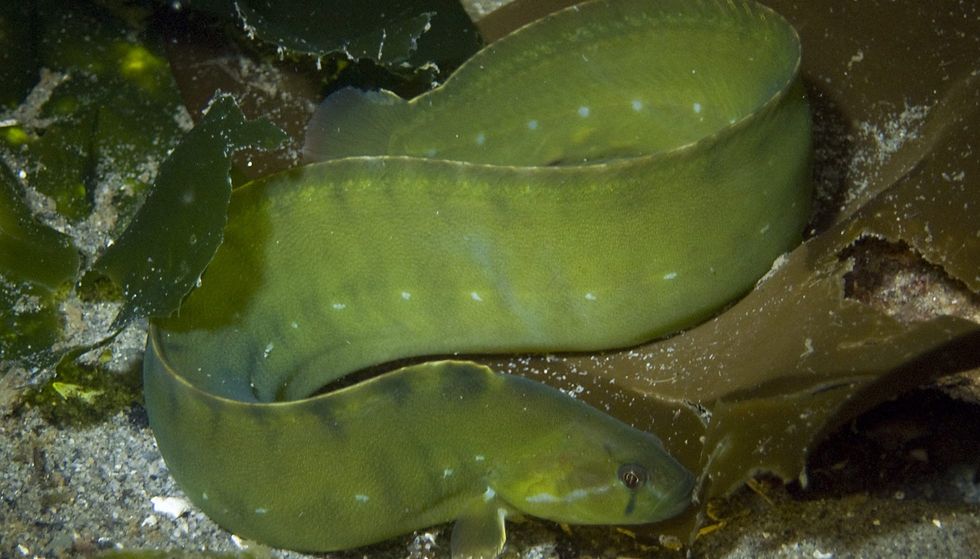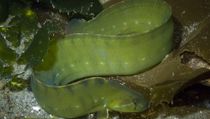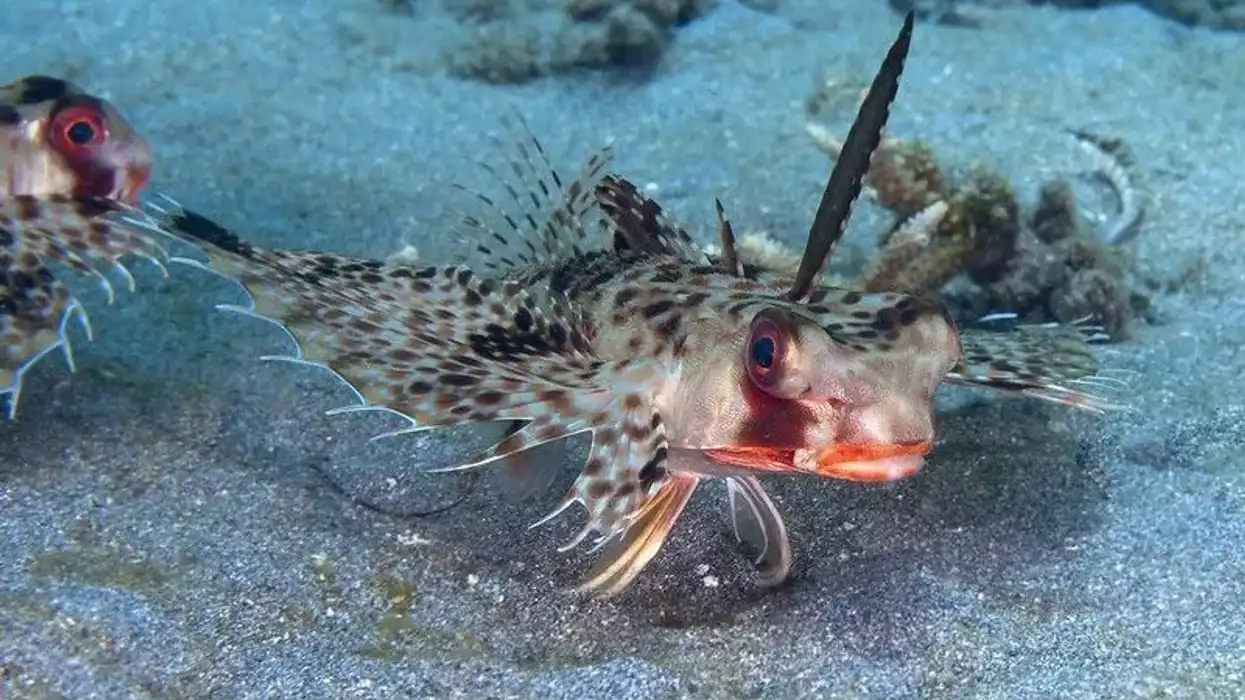Gunnels are a kind of fish found at the bottom of the ocean in subtidal, low tide, or intertidal regions of the North American and Atlantic shores. They have about eight recognized species and are named usually after their body, color, or habitat.
The two species that are most widely known are the rock gunnel fish or butterfish gunnel (Pholis gunnellus) and the crescent gunnel (Pholis laeta).
Gunnels are capable of camouflaging themselves with their surroundings, so they occur in various colors such as brown, orange, and bright green.
The spots on their bodies also have various shapes to fit the appearance of their habitat. They are characterized by a dorsal fin that runs almost throughout the length of their slender, flattened body.
They usually are meek creatures that slither into the rock crevices whenever they come in proximity of humans or any large animals. They also acquire their food from the ocean floor in the form of crustaceans, mollusks, fish eggs and, worms.
These fishes are also often caught and their sweet flesh is sold in the market in areas such as Delaware Bay and other North American regions.
If you like reading about fishes, their habitat, and all the lesser-known facts about them, make sure to check out gulf toadfish and lionfish.
Gunnel Fish Interesting Facts
What type of animal is a gunnel fish?
The gunnel fish of the family Pholidae is a sleek-looking fish that is often mistaken for an eel.
What class of animal does a gunnel fish belong to?
Scientifically speaking, the class that Pholis gunnellus belongs to is known as Actinopterygii. However, in popular culture, the class that they are identified with widely is fish.
How many gunnel fish are there in the world?
There are no studies that can tell us the exact number of gunnel fish found in the world, but the fact that their conservation status is Not Evaluated suggests that these beautiful fishes are not reducing in numbers!
Where does a gunnel fish live?
Rock gunnel fish can usually be found in intertidal low tide and subtidal shallow waters of the ocean which means that they can adapt to varying depths of water.
What is a gunnel fish's habitat?
Pholis Gunnellus and the varied subspecies occur largely in the shallow waters around the North Atlantic region. Crescent gunnels occur around northern California and around Delaware Bay. They usually inhabit the crevices of rocks and algae at the bottom of the ocean.
Who do gunnel fish live with?
The rock gunnel (Pholis gunnellus) is not a very sociable species. They choose to live in crevices and camouflage themselves which suggests that they prefer solitude and safety. They hardly swim long distances which also means that they do not live in large schools. However, they are not aggressive towards other animals and thrive with their own kind.
How long does a gunnel fish live?
The maximum age that Atlantic species such as crescent gunnels and butterfish gunnels can live up to is five years.
How do they reproduce?
Gunnels are egg-layers, although not much else is known about their reproduction patterns. Spawning is usually considered to take place in the winter months, during which the male rock gunnel fish makes a nest for the eggs to be laid in. The males protect the nest until hatching.
What is their conservation status?
According to the IUCN, gunnel fishes are Not Evaluated which means that their habitat faces no immediate and irreversible threat.
Gunnel Fish Fun Facts
What do gunnel fish look like?
Usually mistaken due to their sleek body, the rock gunnel (Pholis gunnellus) is an eel-like fish that lives in the crevices between rocks and algae on the ocean floor. Their color can range from red, mud brown, black and green to best facilitate camouflaging into their surroundings.
They also have a dorsal fin that runs along their body. Their long and spotted body makes them susceptible to be mistaken for an eel.
They also have a small, blunt head and a protruding lower jaw. They belong to the family Pholidae which is characterized by its long body and colorful markings.
How cute are they?
Gunnel fishes with their crescent-shaped markings, as in the case of crescent gunnels, long dorsal fin, and color-changing abilities are impeccably cute creatures of the intertidal, shallow waters of the Atlantic.
How do they communicate?
There are no conclusive studies as to how gunnels communicate with each other. Furthermore, it is unlikely due to their nature that they would be too communicative at all.
How big is a gunnel fish?
The rock gunnel can grow up to a length of about 12 in (30.4 cm) which is less than half of the average size of an eel. An eel can grow up to 29 in (73.6 cm).
How fast can a gunnel fish swim?
The rock gunnel (Pholis gunnellus) is characterized by its tendency to quickly hide between rocks or algae in order to save itself from predators. Such a tendency calls for them to be fast swimmers which they are. The rock gunnel (Pholis gunnellus) can swim at a speed of about 0.7 mph (1.12 kph).
How much does a gunnel fish weigh?
While there are no conclusive studies regarding the exact weight of rock gunnel fish, it is understood that their small build and their tendency to be fast-swimmers imply that they are considerably light-weighted.
What are the male and female names of the species?
The rock gunnel and other related species do not have distinguished names for the two sexes. They are referred to as male and female rock gunnel fish.
What would you call a baby gunnel fish?
A baby rock gunnel fish, much like its parents, does not have any specific name. Although, you may call them pups.
What do they eat?
Usually a bottom-dwelling species, these fishes feed on crustaceans such as small crabs and shrimps, mollusks such as mussels and limpets, worms, and fish eggs which are available to them in abundance on the ocean floor.
Are they poisonous?
There are no studies that would suggest that the rock gunnel, crescent gunnel, or butterfish gunnel are poisonous or even harmful to humans. In fact, there are certain studies that would be a great boom for the fishing industry if the range of areas where they are consumed was larger.
Would they make a good pet?
Understanding that this species is of a meek character and would be tough to take care of given their diet and habitat, it is unlikely that they would make a good pet. Although, it is obvious that their snake-like length and beautiful markings make them very attractive.
Did you know...
Gunnel fish, unlike other related fishes, can breathe air. This allows them to survive in crevices where water is scarce to none. During low tides, they come up to the surface of the water and breathe air for survival.
How did the gunnel fish get its name?
The family of gunnels and various related species are called by different names such as crescent gunnel (Pholis laeta), rock gunnel (Pholis gunnellus), or butterfish gunnel. The crescent gunnel is named after the crescent-shaped markings on its body, while the butterfish gunnel is named by the fishing community due to its slippery body.
Do gunnel fish have scales?
Gunnels have small scales that are almost hidden completely under their slimy skin. This arrangement allows them to slither into crevices without much friction, and to flee from unfavorable situations such as fisherman and predatory fishes.
Here at Kidadl, we have carefully created lots of interesting family-friendly animals facts for everyone to discover! Learn more about some other fish from our electric eel facts and giant frogfish facts pages.
You can even occupy yourself at home by coloring in one of our free printable Gunnel fish coloring pages.










